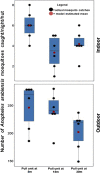Evaluation of a push-pull system consisting of transfluthrin-treated eave ribbons and odour-baited traps for control of indoor- and outdoor-biting malaria vectors
- PMID: 30894185
- PMCID: PMC6427877
- DOI: 10.1186/s12936-019-2714-1
Evaluation of a push-pull system consisting of transfluthrin-treated eave ribbons and odour-baited traps for control of indoor- and outdoor-biting malaria vectors
Abstract
Background: Push-pull strategies have been proposed as options to complement primary malaria prevention tools, indoor residual spraying (IRS) and long-lasting insecticide-treated nets (LLINs), by targeting particularly early-night biting and outdoor-biting mosquitoes. This study evaluated different configurations of a push-pull system consisting of spatial repellents [transfluthrin-treated eave ribbons (0.25 g/m2 ai)] and odour-baited traps (CO2-baited BG-Malaria traps), against indoor-biting and outdoor-biting malaria vectors inside large semi-field systems.
Methods: Two experimental huts were used to evaluate protective efficacy of the spatial repellents (push-only), traps (pull-only) or their combinations (push-pull), relative to controls. Adult volunteers sat outdoors (1830 h-2200 h) catching mosquitoes attempting to bite them (outdoor-biting risk), and then went indoors (2200 h-0630 h) to sleep under bed nets beside which CDC-light traps caught host-seeking mosquitoes (indoor-biting risk). Number of traps and their distance from huts were varied to optimize protection, and 500 laboratory-reared Anopheles arabiensis released nightly inside the semi-field chambers over 122 experimentation nights.
Results: Push-pull offered higher protection than traps alone against indoor-biting (83.4% vs. 35.0%) and outdoor-biting (79% vs. 31%), but its advantage over repellents alone was non-existent against indoor-biting (83.4% vs. 81%) and modest for outdoor-biting (79% vs. 63%). Using two traps (1 per hut) offered higher protection than either one trap (0.5 per hut) or four traps (2 per hut). Compared to original distance (5 m from huts), efficacy of push-pull against indoor-biting peaked when traps were 15 m away, while efficacy against outdoor-biting peaked when traps were 30 m away.
Conclusion: The best configuration of push-pull comprised transfluthrin-treated eave ribbons plus two traps, each at least 15 m from huts. Efficacy of push-pull was mainly due to the spatial repellent component. Adding odour-baited traps slightly improved personal protection indoors, but excessive trap densities increased exposure near users outdoors. Given the marginal efficacy gains over spatial repellents alone and complexity of push-pull, it may be prudent to promote just spatial repellents alongside existing interventions, e.g. LLINs or non-pyrethroid IRS. However, since both transfluthrin and traps also kill mosquitoes, and because transfluthrin can inhibit blood-feeding, field studies should be done to assess potential community-level benefits that push-pull or its components may offer to users and non-users.
Keywords: CO2-baited BG-malaria traps; Early-night biting; Outdoor-biting; Push–pull; Semi-field chamber; Transfluthrin treated eave-ribbons.
Conflict of interest statement
The authors declare that they have no competing interests.
Figures





Similar articles
-
Insecticide-treated eave ribbons for malaria vector control in low-income communities.Malar J. 2021 Oct 23;20(1):415. doi: 10.1186/s12936-021-03945-2. Malar J. 2021. PMID: 34688285 Free PMC article. Review.
-
Eave ribbons treated with the spatial repellent, transfluthrin, can effectively protect against indoor-biting and outdoor-biting malaria mosquitoes.Malar J. 2018 Oct 17;17(1):368. doi: 10.1186/s12936-018-2520-1. Malar J. 2018. PMID: 30333015 Free PMC article.
-
Eave ribbons treated with transfluthrin can protect both users and non-users against malaria vectors.Malar J. 2019 Sep 18;18(1):314. doi: 10.1186/s12936-019-2958-9. Malar J. 2019. PMID: 31533739 Free PMC article.
-
Protecting migratory farmers in rural Tanzania using eave ribbons treated with the spatial mosquito repellent, transfluthrin.Malar J. 2019 Dec 10;18(1):414. doi: 10.1186/s12936-019-3048-8. Malar J. 2019. PMID: 31823783 Free PMC article.
-
Reshaping the vector control strategy for malaria elimination in Ethiopia in the context of current evidence and new tools: opportunities and challenges.Malar J. 2018 Dec 5;17(1):454. doi: 10.1186/s12936-018-2607-8. Malar J. 2018. PMID: 30518395 Free PMC article. Review.
Cited by
-
Insecticide-treated eave ribbons for malaria vector control in low-income communities.Malar J. 2021 Oct 23;20(1):415. doi: 10.1186/s12936-021-03945-2. Malar J. 2021. PMID: 34688285 Free PMC article. Review.
-
Sodium channel activation underlies transfluthrin repellency in Aedes aegypti.PLoS Negl Trop Dis. 2021 Jul 8;15(7):e0009546. doi: 10.1371/journal.pntd.0009546. eCollection 2021 Jul. PLoS Negl Trop Dis. 2021. PMID: 34237076 Free PMC article.
-
Entomological assessment of hessian fabric transfluthrin vapour emanators for protecting against outdoor-biting Aedes aegypti in coastal Tanzania.PLoS One. 2024 May 29;19(5):e0299722. doi: 10.1371/journal.pone.0299722. eCollection 2024. PLoS One. 2024. PMID: 38809841 Free PMC article.
-
Effect of Ivermectin® on survivorship and fertility of Anopheles arabiensis in Ethiopia: an in vitro study.Malar J. 2023 Jan 9;22(1):12. doi: 10.1186/s12936-023-04440-6. Malar J. 2023. PMID: 36624480 Free PMC article.
-
Biology and bionomics of malaria vectors in India: existing information and what more needs to be known for strategizing elimination of malaria.Malar J. 2019 Dec 3;18(1):396. doi: 10.1186/s12936-019-3011-8. Malar J. 2019. PMID: 31796010 Free PMC article. Review.
References
-
- WHO . World Malaria Report 2017. Geneva: World Health Organization; 2017.
-
- World Health Organization . Global Malaria Programme Global technical strategy for malaria, 2016–2030. Geneva: World Health Organization; 2015.
Publication types
MeSH terms
Substances
Grants and funding
LinkOut - more resources
Full Text Sources
Research Materials

